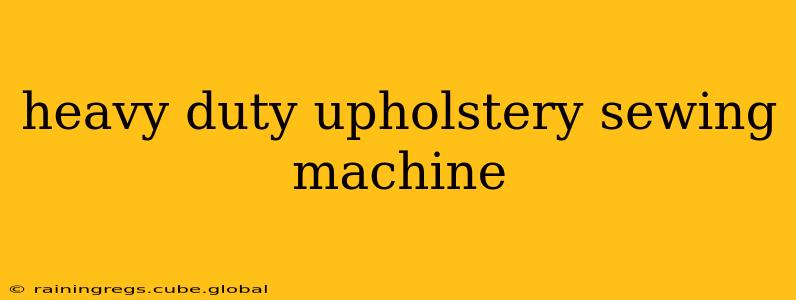Choosing the right sewing machine for upholstery can significantly impact your efficiency and the quality of your finished projects. Heavy-duty upholstery sewing machines are built to withstand the rigors of working with thick fabrics, multiple layers, and demanding stitching tasks. This comprehensive guide will help you navigate the world of heavy-duty upholstery sewing machines, answering common questions and providing valuable insights for both beginners and experienced upholsterers.
What Makes a Sewing Machine "Heavy Duty"?
A true heavy-duty upholstery sewing machine is distinguished by several key features:
-
Robust Construction: These machines are built with stronger internal components, including a heavier frame, reinforced stitching mechanisms, and a powerful motor. This ensures durability and prevents breakdowns when working with challenging materials.
-
Powerful Motor: A high-powered motor is essential for piercing thick fabrics and maintaining consistent stitch speed even under heavy load. Look for machines with motors capable of handling multiple layers of durable materials like leather, vinyl, and heavy canvas.
-
High-Speed Stitching: While not always essential, high-speed stitching capabilities can boost your productivity significantly, especially on large projects.
-
Long Feed Dogs: Longer feed dogs ensure smooth, even feeding of thick fabrics, preventing bunching and skipped stitches.
-
Adjustable Stitch Length and Width: These features offer versatility, allowing you to tailor your stitches to the specific requirements of different fabrics and projects.
-
Heavy-Duty Needle Plate: The needle plate is designed to withstand the stress of thicker needles and heavier fabrics.
What are the Best Brands of Heavy Duty Upholstery Sewing Machines?
Several brands consistently produce high-quality heavy-duty upholstery sewing machines. Researching specific models within these brands is crucial, as features and capabilities vary:
- Singer: Singer offers a range of heavy-duty models renowned for their reliability and ease of use.
- Juki: Juki is a popular choice among professionals, known for their robust construction and powerful motors.
- Consew: Consew machines are often favored for their industrial-strength build and ability to handle the toughest upholstery projects.
- Durkopp Adler: Durkopp Adler produces high-end industrial sewing machines, some of which are suitable for demanding upholstery applications.
What types of needles are best for heavy-duty upholstery sewing?
Choosing the right needle is crucial for success in upholstery sewing. You'll typically need heavy-duty needles designed for thick fabrics and tough materials. Look for needles with larger shafts and points to accommodate the thickness of the materials. Leather needles, denim needles, and heavy-duty universal needles are common choices depending on the specific fabric. Always consult your machine's manual for recommended needle sizes.
How much does a heavy-duty upholstery sewing machine cost?
The cost of a heavy-duty upholstery sewing machine can range significantly, from a few hundred dollars for entry-level models to several thousand dollars for high-end industrial machines. The price reflects the machine's build quality, features, and capabilities. Consider your budget and the frequency of use when making your decision.
What are the main differences between a regular sewing machine and a heavy-duty upholstery sewing machine?
The primary difference lies in the machine's construction and power. A regular sewing machine is not built to handle the stress of consistently sewing through thick, multiple layers of heavy fabric. Heavy-duty upholstery machines have reinforced components, more powerful motors, and features designed to handle these demanding tasks without breaking down or producing poor-quality stitching.
How do I maintain my heavy-duty upholstery sewing machine?
Regular maintenance is key to extending the life of your machine. This includes:
- Regular oiling: Keep the machine well-lubricated to prevent friction and wear.
- Cleaning: Remove lint and debris regularly to prevent jamming.
- Needle replacement: Change needles frequently to ensure optimal stitch quality.
- Following the manufacturer's instructions: Consult your machine's manual for specific maintenance recommendations.
By carefully considering these factors and selecting a machine that meets your specific needs and budget, you can confidently tackle even the most challenging upholstery projects. Remember to always prioritize quality over price and choose a machine that is built to last.
